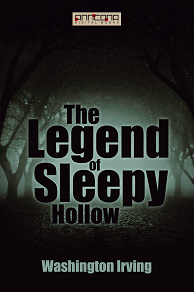
Isbn:
978-91-7605-106-1
Förlag: Anncona Media
Kategori:
Noveller Fantasy & SF Engelskspråkiga
Tillgänglig sedan: mars 2014
Förlag: Anncona Media
Kategori:
Noveller Fantasy & SF Engelskspråkiga
Tillgänglig sedan: mars 2014
E-bok
The Legend of Sleepy Hollow
The Legend of Sleepy Hollow is a short story by Washington Irving contained in his collection The Sketch Book of Geoffrey Crayon, Gent., written while he was living in Birmingham, and first published in 1820. With Irving's companion piece "Rip Van Winkle", "The Legend of Sleepy Hollow" is among the earliest examples of American fiction still read today.
The more spectral elements of "The Legend of Sleepy Hollow" were likely based on German folktales concerning "The Wild Huntsman", a ghoulish phantom that would chase interlopers through the woods at maddening speeds. Often this apparition was headless and its victims lacking in virtue or morality. Irving wrote The Sketch Book during a tour of Europe, and German ghost stories proved especially inspiring to his imagination. One particularly influential rendition of this folktale was recorded by the German folklorist Karl Musäus. Headless horsemen were staples of Northern European storytelling, featuring in German, Irish (e.g. Dullahan), Scandinavian (e.g. the Wild Hunt), and English legends. Decapitated riders were known to race through the countryside, heads tucked under their arms, followed by hordes of coal-black hounds with fiery tongues. Usually viewed as omens of ill-fortune for those who chose to disregard their apparitions, these specters found their victims in proud, scheming persons and characters with hubris and arrogance.
During the height of the American Revolutionary War, Irving writes that the country surrounding Tarry Town "was one of those highly-favored places which abound with chronicle and great men. The British and American line had run near it during the war; it had, therefore, been the scene of marauding, and infested with refugees, cow-boys, and all kinds of border chivalry." Westchester County was the site of many raids, skirmishes, war crimes, marauding, and ravishing after the Continental Army abandoned it in October 1776. The British occupied the country south of the Bronx River, and the Americans were fortified north of Peekskill, leaving Westchester County a thirty-mile stretch of scorched and desolated no-man's land, vulnerable to outlaws, raiders, and vigilantes. Besides droves of Loyalist rangers and British light infantry, Hessian Jägers—renowned sharpshooters and horsemen—were among the raiders that often skirmished with Patriot militias. The Headless Horseman, said to be a decapitated Hessian soldier, may have indeed been based loosely on the discovery of just such a Jäger's headless corpse found in Sleepy Hollow after a violent skirmish, and later buried by the Van Tassel family in an unmarked grave in the Old Dutch Burying Ground. The dénouement of the fictional tale is set at the bridge over the Pocantico River in the area of the Old Dutch Church and Burying Ground in Sleepy Hollow.
Washington Irving (1783-1859) was an American author, essayist, biographer, historian, and diplomat of the early 19th century. He is best known for his short stories "The Legend of Sleepy Hollow" and "Rip Van Winkle", both of which appear in his book The Sketch Book of Geoffrey Crayon, Gent. His historical works include biographies of George Washington, Oliver Goldsmith and Muhammad, and several histories of 15th-century Spain dealing with subjects such as Christopher Columbus, the Moors, and the Alhambra. Irving served as the U.S. ambassador to Spain from 1842 to 1846
The more spectral elements of "The Legend of Sleepy Hollow" were likely based on German folktales concerning "The Wild Huntsman", a ghoulish phantom that would chase interlopers through the woods at maddening speeds. Often this apparition was headless and its victims lacking in virtue or morality. Irving wrote The Sketch Book during a tour of Europe, and German ghost stories proved especially inspiring to his imagination. One particularly influential rendition of this folktale was recorded by the German folklorist Karl Musäus. Headless horsemen were staples of Northern European storytelling, featuring in German, Irish (e.g. Dullahan), Scandinavian (e.g. the Wild Hunt), and English legends. Decapitated riders were known to race through the countryside, heads tucked under their arms, followed by hordes of coal-black hounds with fiery tongues. Usually viewed as omens of ill-fortune for those who chose to disregard their apparitions, these specters found their victims in proud, scheming persons and characters with hubris and arrogance.
During the height of the American Revolutionary War, Irving writes that the country surrounding Tarry Town "was one of those highly-favored places which abound with chronicle and great men. The British and American line had run near it during the war; it had, therefore, been the scene of marauding, and infested with refugees, cow-boys, and all kinds of border chivalry." Westchester County was the site of many raids, skirmishes, war crimes, marauding, and ravishing after the Continental Army abandoned it in October 1776. The British occupied the country south of the Bronx River, and the Americans were fortified north of Peekskill, leaving Westchester County a thirty-mile stretch of scorched and desolated no-man's land, vulnerable to outlaws, raiders, and vigilantes. Besides droves of Loyalist rangers and British light infantry, Hessian Jägers—renowned sharpshooters and horsemen—were among the raiders that often skirmished with Patriot militias. The Headless Horseman, said to be a decapitated Hessian soldier, may have indeed been based loosely on the discovery of just such a Jäger's headless corpse found in Sleepy Hollow after a violent skirmish, and later buried by the Van Tassel family in an unmarked grave in the Old Dutch Burying Ground. The dénouement of the fictional tale is set at the bridge over the Pocantico River in the area of the Old Dutch Church and Burying Ground in Sleepy Hollow.
Washington Irving (1783-1859) was an American author, essayist, biographer, historian, and diplomat of the early 19th century. He is best known for his short stories "The Legend of Sleepy Hollow" and "Rip Van Winkle", both of which appear in his book The Sketch Book of Geoffrey Crayon, Gent. His historical works include biographies of George Washington, Oliver Goldsmith and Muhammad, and several histories of 15th-century Spain dealing with subjects such as Christopher Columbus, the Moors, and the Alhambra. Irving served as the U.S. ambassador to Spain from 1842 to 1846
Logga in för att låna
Information
Stöds av följande plattformar
PC/Mac
Surfplatta Läsplatta
Smartphone
